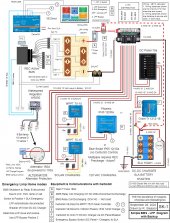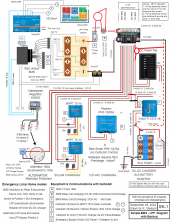Thanks.
@svsagres @Goboatingnow
Yes, I've been disconnecting the the MC4's before hurricanes, with our new dodger SunPower panels. Its only 100w right now.
Two SunPower 50w + Two Sungard Controllers
Photos of installation:
Goal of this thread: Show multiple photos of solar panel installations on boats (sail or power) along with some descriptive text to identify the type of installation , location, effectiveness, and
www.cruisersforum.com
They are easily stowed before tropical storms and hurricanes, at some point before installing lithium I will change to MPPT controllers that are mounted inside where it is dry!
However don't I need to have some 5a fuses in the Solar Panel circuits?
Also I think I will use the Lynx bus differently now. The MPPT wiring to the Lynx will be a dual set of wires up to the center +/- posts that don't support a fuse. I will then provide two inline 15a fuses just below the Lynx. I think this is more acceptable wiring.
The Orion Tr Charger can then be moved to the free fused +/- on the Lynx since we now have it automatically turned on when the Switch Position is in Off - LFP Normal. I still need to show a fuse at the battery.
Question: Isn't the
RBS switch the same function as the "LFP Override" in the 1-Off-2 Switch above?
From the link above:
What Jedi (Nick) says "With the RBS, you can manually switch it off." What he means is actually "
Override the BMS". According to him this is in violation of






